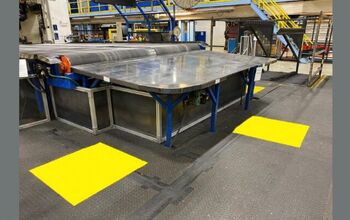Piston Slap: Safe Thinking on Dry-Rotted Tires?

Jimmy writes:
Sajeev,
For years I traded in my Hondas and Toyotas within 18 months of purchase. However, I did not care for the newest Highlander, Pilot, and Camry, so I kept the old ones hoping the next versions would be more acceptable. While I have not had a single problem with these vehicles, with the exceptions of a few light bulbs, I’ve noticed Michelin Green X and the Continental ContiProContact have small cracks in the tread grooves. The tires have 40,000 and 55,000 miles on them with lots of tread left. I have asked tire stores and some say don’t worry while others say they are dangerous.
What is the rule for tire replacements when it comes to cracks in the tread grooves?
Sajeev answers:
A timely query: my once-new 2011 Ford Ranger is old enough for new rubber. I noticed those cracks, even with decent tread and “good” rubber between them and the wear bars. And, just like you, I certainly ain’t trading it in for a new Ranger anytime soon!
This indicates dry rotted tires, which means harder, slippery and unsafe rubber in wet/aggressive driving conditions. As the cracks grow, blow outs and tread separation failures are likely. Given the mileage, I assume your tires are also five-ish years old. Tire manufacturers have a hard stop on replacement after 10 years, while car makers (fearing Firestone-esque lawsuits?) recommend six-year replacement intervals. For a daily driven and/or primary vehicle, I’d lean closer to the six-year interval for safety concerns.
Depending on the climate (heat is the concern) and UV exposure (garaged?), I reckon we both need new tires soon. The top picture is the factory ContiTrac on my rig. The dry rot is closer to hairline cracks, not replicas of Grand Canyons. Given their admirable performance during Houston’s recent floods, these tires have several more months of life, but I’m rollin’ on borrowed time.
But looking at them up close?
Those are bigger than I remember from my last “wait for the oil to drain out” tire inspection. While I don’t see myself on a looong highway trip in the future, this is a cause for concern.
So will Sanjeev treat himself to 10 mm wider rubber so contact patch isn’t stretched so tightly and the speedo might read accurately? The autoblogosphere is dying to know!
[Images: © 2016 Sajeev Mehta/The Truth About Cars]
Send your queries to sajeev@thetruthaboutcars.com. Spare no details and ask for a speedy resolution if you’re in a hurry…but be realistic, and use your make/model specific forums instead of TTAC for more timely advice.
Also, if your tires suck and you’re shopping for new tires, help support TTAC’s work by doing your research at TireReviewsandMore.com. — TTAC staff.

More by Sajeev Mehta
Latest Car Reviews
Read moreLatest Product Reviews
Read moreRecent Comments
- AZFelix What could possibly go wrong with putting your life in the robotic hands of precision crafted and expertly programmed machinery?
- Orange260z I'm facing the "tire aging out" issue as well - the Conti ECS on my 911 have 2017 date codes but have lots (likely >70%) tread remaining. The tires have spent quite little time in the sun, as the car has become a garage queen and has likely had ~10K kms put on in the last 5 years. I did notice that they were getting harder last year, as the car pushes more in corners and the back end breaks loose under heavy acceleration. I'll have to do a careful inspection for cracks when I get the car out for the summer in the coming weeks.
- VoGhost Interesting comments. Back in reality, AV is already here, and the experience to date has been that AV is far safer than most drivers. But I guess your "news" didn't tell you that, for some reason.
- Doc423 Come try to take it, Pal. Environmental Whacko.
- 28-Cars-Later Mazda despite attractive styling has resale issues - 'Yota is always the answer.



































Comments
Join the conversation
Those surface cracks wouldn't bother me. I've seen far worse. But I have a relatively high tolerance for risk. New tires certainly would be safer, allowing a much greater safety factor in an adverse situation such as an under-inflated tire at high speed. They'll also likely have considerably more grip. Structural problems - deformation or sidewall bubbles - are more of a concern to me. Tires with those issues should be replaced immediately. Slow right down and check things out if anything feels unusual. Any tire that's worthy of driving at highway speed should have no vibrations. The older a tire is, the more frequently and thoroughly it should be inspected.
I have noticed that Michelin tires seem to be more prone to cracking that other brands. The MXV4s that I put on my station car had cracking between the treads after 7 years of being outside. Still had tread life but they failed inspection. Funny, my Michelin bicycle tires did the same thing...